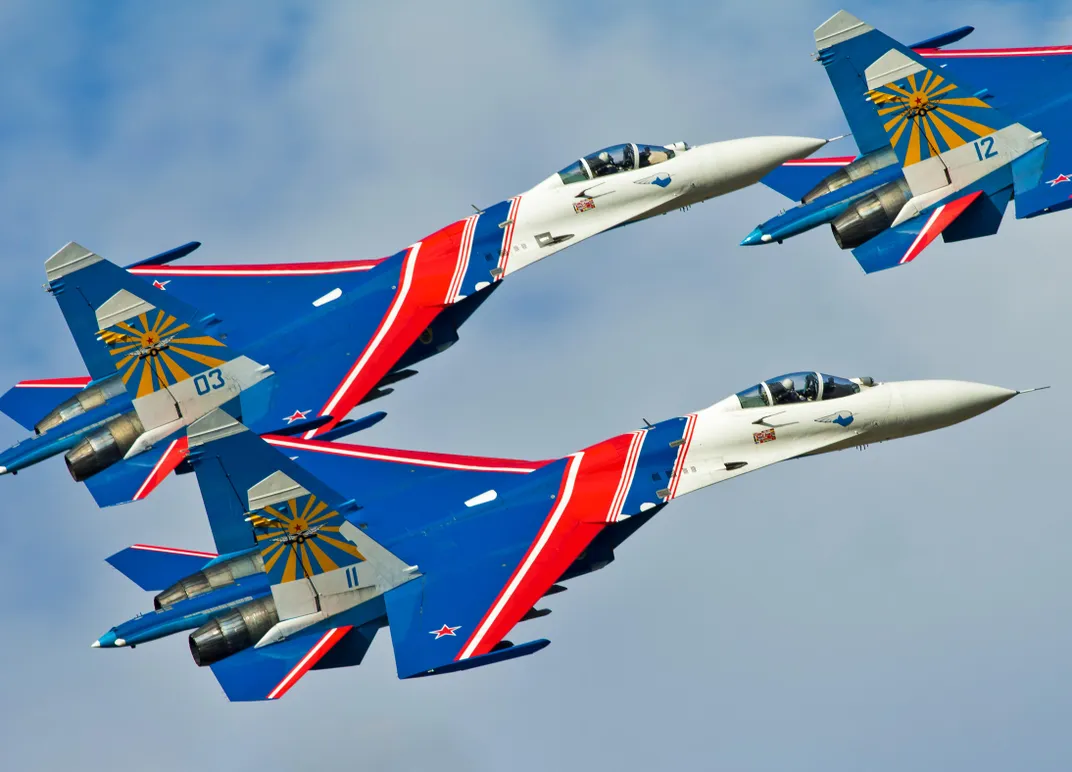The Russian Jet That Fights for Both Sides
What Ukrainian air force pilots had to say about their aging Su-27s.
:focal(2275x1272:2276x1273)/https://tf-cmsv2-smithsonianmag-media.s3.amazonaws.com/filer/fc/d2/fcd22068-206d-4d26-bfe8-49c2b3c7f471/08c_on2020_cduncanmonk2.jpg)
Editors' note, March 11, 2022: As the Russian invasion of Ukraine continues, we are resurfacing this 2020 story from Air and Space magazine about the plane still used in the ongoing air battles by Ukrainian and Russian forces. One of the Ukrainian pilots the magazine spoke with, Oleksandr Oksanchenko, was shot down and killed in action by a Russian surface-to-air missile. On February 28, he was posthumously awarded the title Hero of Ukraine, the nation’s highest award for valor in combat.
The powerful Sukhoi Su-27 has patrolled Ukrainian skies for 35 years; at first, as a Soviet fighter to counter the threat posed by the U.S. F-15 Eagle and today, as a Ukrainian air force interceptor protecting its airspace from Russian Su-27s and other fighters. The Flanker, as NATO named it, debuted in the West at the 1989 Paris Air Show, four years after it entered service. Test pilot Viktor Pugachev stunned the crowd with his signature “cobra” maneuver, pitching his sky-blue Sukhoi up to beyond vertical and skidding it forward on its tail, proving the fighter’s super-maneuverability.
The Soviet air force 1969 specification for its new fighter design boiled down to this: Outperform the F-15. The first attempts failed, and chief designer Mikhail Simonov took a radical step. He halted development in 1977, and began again, virtually from scratch. As Simonov said, “We kept just the tires and the pilot’s seat.”
The fighter did not reach operational regiments until 1985, and only in 1990, after it passed service trials, was it designated the Su-27. (There were two versions. The Su-27P was an interceptor, while the -S could use unguided air-to-ground weapons.)
The first Soviet unit to receive the Flanker was the 831st Fighter Regiment (now Brigade) based at Myrhorod, in the former Soviet republic of Ukraine. The 831st was considered among the best fighter units in the Soviet Union.
After the USSR collapsed, 72 Su-27 fighters based in Ukraine stayed in Ukraine. Many of the aircraft were from early, inferior production blocks. In 2009, amid declining relations with Russia, the Ukrainian air force began to have difficulty obtaining spare parts from Sukhoi, and maintenance became thorny. Although total aircraft numbers have declined only slightly—five Su-27s have been lost to pilot error and nine more sold abroad—many airframes have become sources of spares for the active fleet. In 2014, when Russia annexed the Crimean peninsula and began heavily supporting separatists in eastern Ukraine, only 19 Su-27s were serviceable. Among the Ukrainian Su-27s that sprang into action were those of Myrhorod’s 831st Fighter Regiment.
In the decade before the Russian attack, the Ukrainian aircraft industry, which boasts the famed Antonov design bureau, began to upgrade its fighters. The Su-27M1, as Ukraine designates the modified aircraft, has new navigation systems, a radar with greater range, and an increased ability to use unguided air-to-ground munitions. Although Ukraine also flies the MiG-29 Fulcrum, the Flanker has a much greater combat range, better armament, and longer-range radar compared with the MiG. As such, the Su-27 is Ukraine’s main offensive and defensive pillar, while the short-range MiG handles point-defense.
Today, Ukraine works closely with NATO nations, including the United States. At Myrhorod, where P-51 Mustangs of the 4th Fighter Group once took off to escort B-17s on raids against Germany, American units occasionally visit to fly exercises with and against (and sometimes, in) the Sukhois. In 2011 and 2018, U.S. Air National Guard F-16s and -15s flew to Ukraine for the multinational air force exercises Safe Skies and Clear Sky.
Although the Ukrainian Su-27 is inferior to the newest Russian Su-27SM2, Su-30 Flanker-C, and Su-35 Flanker-Е fighters, it remains a reliable weapons platform with plenty of airframe life remaining. With the addition of Western avionics and other systems, it could remain an important component of Ukraine’s defense for a long time to come. These pilots describe its power—and its idiosyncracies.
Major General Vladimir Alexeyev (retired), former head of Combat Training Directorate:
I received theoretical instruction on the Su-27 in spring 1990 and started flying Flankers at Myrhorod that summer.
Something which really gave me a positive impression of the Flanker is its jaw-dropping thrust-to-weight ratio. I was also surprised by the exceptional view from the cockpit. When I first rolled an Su-27, I felt as if I was going to fall out of the cockpit! Another surprise was the ease of flying. The new fly-by-wire controls gave the impression that you just think of doing something, and the airplane does it as if of its own accord.
The Flanker’s speed and acceleration are good, but there is one [bad side-effect]. Once you exceed 850 to 900 kilometers per hour (528 to 559 mph) in a twin-seat Flanker, or 900 kilometers per hour in a single-seat version, the cockpit noise increases with the increase in speed. This is because of the bubble canopy. The disturbed airflow behind the canopy creates a crashing sound. It would sometimes get so loud at speeds in excess of 1,100 kilometers per hour that you couldn’t hear the radio.
In March 1997, I demonstrated the Su-27 in flight for U.S. Air Force General Mike Ryan, at that time commander of [U.S. Air Forces in Europe] and later U.S. Air Force Chief of Staff. After the takeoff, I gave him the controls, and he immediately pulled 7Gs! He wanted to see how quickly the Flanker pulls up. The Eagle is a little wooden when pulling up, a little slow. The General wanted to compare and pulled the stick back quickly, as you do in an F-15. The Flanker immediately pulled up, almost vertically. Mike Ryan didn’t expect that he would pull so many Gs when doing that, because he was flying like in an F-15, with quick, wide stick movements, which you can use in the very stable Eagle. He reacted very well, pushed the stick forward immediately.
When we met in the States the following year, he told me he was surprised by how well the big and powerful Flanker maneuvered.
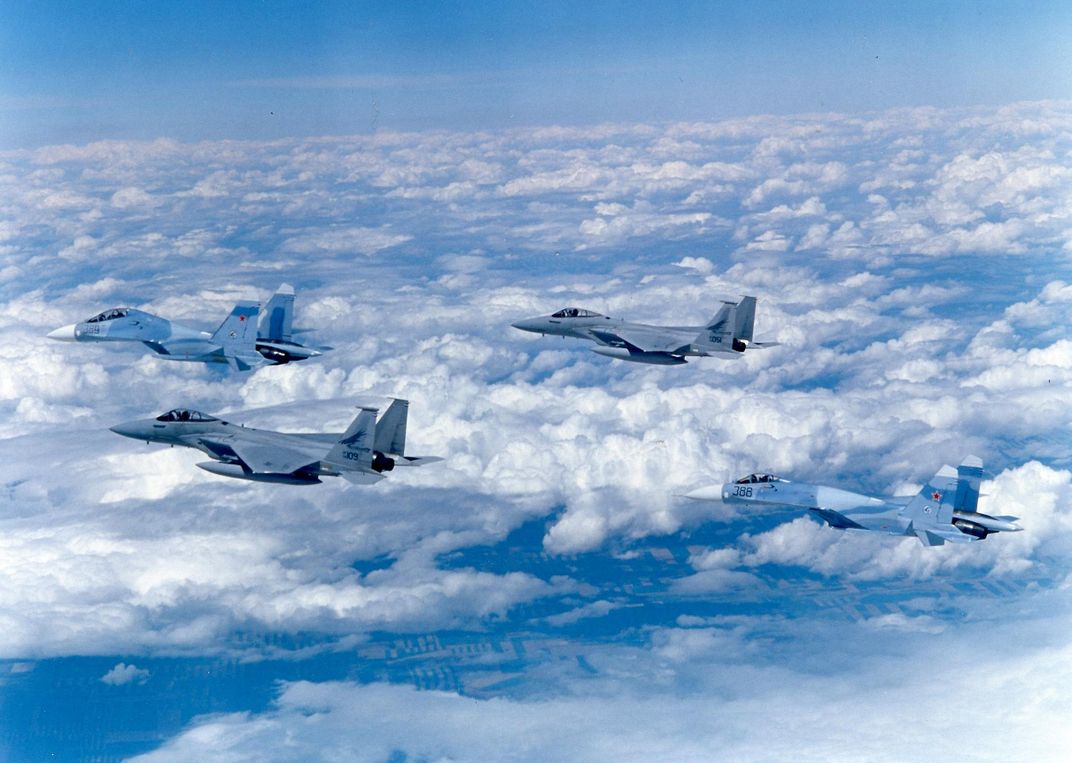
Colonel Yury Bulavka, deputy commander for pilot training of the 831st Galatska Tactical Aviation Brigade.
During the second year of junior high, I decided that I would be a fighter pilot. I looked at videos of famous Soviet Flanker test pilots—Anatoly Kvochur and Viktor Pugachev—but never imagined that I would fly the Su-27 myself.
I first flew in an Su-27UB twin-seat combat trainer in fall 2004. However, because of a fuel shortage in the air force at that time, it wasn’t until 22 April 2007 that I first flew in a single-seat Su-27. It accelerates faster than the twin-seater and is more powerful. The most difficult part of that flight was the landing—nobody was there to assist and monitor me from the rear cockpit, and that was unnerving.
We often flew against the MiG-29 during exercises. It was really interesting to observe how fighters of two very different categories compare: The Fulcrum is light and small, and our Flanker is considerably bigger. The Fulcrum is good in the vertical plane, it can jump up to a higher altitude quickly. The Flanker has more powerful engines, but it is also heavier. The Flanker’s advantage is that it can drag the Fulcrum into horizontal and oblique maneuvers, and conduct these at high angles of attack and speeds, with which the Fulcrum pilots simply won’t be able to cope for long. For example, the same maneuver might require a pilot to pull 5Gs in a Flanker, but requires 7Gs in a Fulcrum.
However, altitude was an important additional factor. The Su-27 is more nimble at sea level and medium altitude than it is above 8,000 meters (26,200 feet), while the MiG-29 is better at higher altitude.
The maneuvering capabilities of the Flanker are excellent, of course. For example, during air combat maneuvering training at the Clear Sky 2018 exercises—with the F-15C Eagles of the 144th Fighter Wing of the California Air National Guard—we won in three out of four engagements. Naturally, you need to survive long enough to close to visual range, because the Eagle’s electronic equipment and armament are much better. Ukraine has factories that manufacture air-to-air missiles, but we are not quite at the level of modern technology. We need fire-and-forget missiles, because illuminating a target with your radar after launch (with semi-active radar homing) is now a relic of the past. The Russians have the R-77 missile with active homing, while our R-27 is still semi-active.
A significant advantage of the Flanker is its long range. It is as if we are carrying extra fuel tanks, but internally, rather than under the wings. This allows us to carry more weapons on the under-wing hardpoints.
/https://tf-cmsv2-smithsonianmag-media.s3.amazonaws.com/filer/06/35/06356f55-92b2-4dd8-b632-5f5ce4663e04/08a_on2020_cockpitsu27_live.jpg)
Colonel Oleksandr Oksanchenko (retired), former deputy commander for pilot training of the 831st Galatska Tactical Aviation Brigade.
I finished the Kharkiv military pilot school in 1989, and remained there as an instructor on the L-39 aircraft until 1995. Once, an Su-27UB twin-seater overflew our airfield on a weather reconnaissance flight. The crew performed a pull-up at low altitude and it captivated us. I did not think then that I would fly a Flanker. Then, in October 1996, I was transferred to the 831st Regiment, and from 1997, flew the Su-27.
My first solo on an Su-27 took place on 15 May 1998. It was a difficult time for the air force, and we flew very little. That didn’t prevent me from gaining a distinct first impression of the Flanker. It’s powerful and accelerates well, especially on take-off. The Flanker is very sensitive in the rolling plane—you pull the stick to the side just a little, and it already wants to perform a barrel roll. When you pull up vertically, the Su-27 zooms across the sky, because of the great amount of available thrust.
Once the air force training budget increased, we strafed real ground targets and launched live missiles. I got a surprise when firing the cannon the first time. The recoil is really strong. The equivalent of seven tons, as it says in the technical manual. The rear-view windows in the cockpit twisted out of position, while the plastic holders for various information sheets started flying around the cockpit. That’s not pleasant at all. Sometimes, firing the gun even caused some radio systems to fail.
Not all the flights were uneventful. Once, during a training combat against another Su-27, an AC generator failed on my aircraft. I switched to the second generator, but it cut out due to the high load—all the aircraft’s systems, including the fly-by-wire controls, weapons management, and gunsight were switched on. Once such a failure happens, the remaining flight time is just 10 minutes, as the voltage in the onboard electrical circuits is maintained only by the batteries. I rapidly returned to home base from a distance of 40 kilometres (25 miles) and landed successfully. The engineer then told me, “You were lucky, the batteries were new!” That was the most dangerous failure I ever experienced.
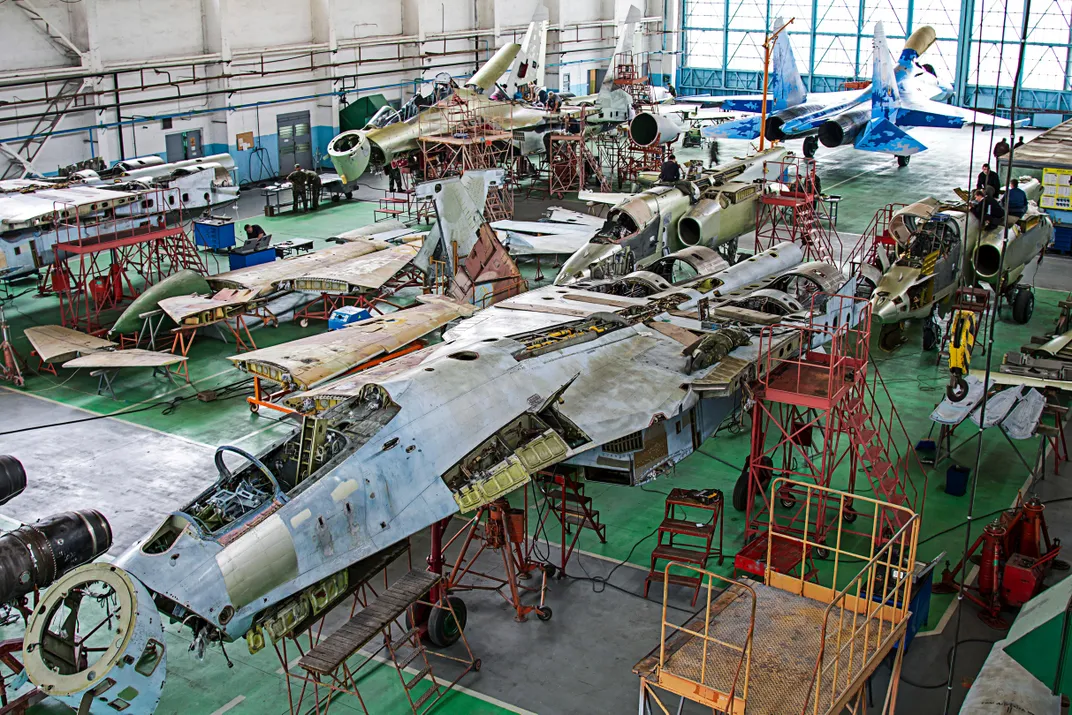
Colonel Dmitry Fisher (retired), former squadron commander in the 831st Galatska Tactical Aviation Brigade.
Back when I was in Chernihiv flight school, I wanted to become a Flanker pilot. It so happened that in 1990, the flight school restarted training on fourth-generation combat aircraft, and we began studying the MiG-29. My goal was the Flanker though, and I deliberately went to the Su-27 base at Myrhorod before our assignments were announced, to get a personnel request letter from the unit. Eventually I was assigned to the unit, as soon as I finished flight school in 1994.
The Flanker is very sensitive to control inputs; the control surfaces move just a little, not nearly as far as on the L-39. The first flight felt like sitting on the end of a needle! The other impression is the great view. The Flanker’s nose is canted down, compared with third-generation aircraft. Sometimes, young pilots are so affected by this that they try to “level out” the aircraft and so raise the nose.
During the war with Russia, I intercepted a Russian Il-20 electronic intelligence turboprop in the area to the south of Donetsk. I did not approach within visual range, but according to my onboard systems, it violated our airspace. I had locked on to it and I could launch a missile, but I was given a weapons-tight order. It wasn’t worth it. The Russians could have used this border violation and its consequences as a pretext for full-scale war.
That wasn’t the only unfriendly case. On several occasions we tracked Russian fighters with our radar on their side of the border. For example, when our An-26s made supply drops for our border guards, encircled by Russian-controlled forces in Krasnodon, the Russians would scramble their fighters every time. There is reason to suspect that one of the [Antonovs] was shot down by an air-to-air missile launched from Russian territory. Our presence deterred them, to a degree.
We had quite a few incidents, because the first production series aircraft, which the 831st Regiment received, had plenty of factory defects. The most serious issues that I experienced were with the hydraulics and the engine oil system. Sometimes I had to land on one engine. Once the hydraulics just blew out completely. The hydraulic fluid entered the fuel system and I was three or so minutes away from having to pull the handle and eject. The maintainers told me this later, when they poured the fuel out of the aircraft and saw that it had turned red.
I flew during Safe Skies 2011, both escort missions and air combat training against F-16s. The dogfights with the F-16s were predominantly two versus two. The Flanker was superior in visual-range combat, but you’ve got to keep in mind that the Flanker and the F-16 belong to different categories of fighters—the Flanker is more powerful. [But] there is another side to the coin. I took a flight in an F-16 and realized that our systems are long obsolete. That’s why the F-16 is superior in beyond-visual-range combat. I can’t get information about the tactical situation in the Flanker, because it was designed on the principle that it would be supplied with tactical information from ground control stations. With those stations available, I would see information on my cockpit display. Now the systems no longer exist, and the only way I can get tactical updates is by voice radio from the ground control officer. The F-16 is completely different. They have a tactical information display and they “see” each other even without making electronic emissions, such as switching on radar.
Colonel Sergey Zhuravlev (retired), former senior inspector pilot of the Combat Training Directorate.
I graduated from the Chernihiv Military Aviation School in 1985. I was assigned to serve on the MiG-23 with the 168th Fighter Regiment [in] Starokostiantyniv. Just after we reported, we happened to visit the 831st Regiment at Myrhorod. We asked to take a look at the aircraft it was flying, and they agreed, but warned us, “Don’t come close. The aircraft is secret!” We didn’t go farther than the smoking area—that’s about 100 meters from the aircraft. Until then, we’d only seen images of the Flanker, and now it was already flying here!
Sometime later, I was lucky to become part of an experiment: four Lieutenants, myself included, all with a third-class rating, were chosen and sent to Lipetsk [in Russia] to convert to the Flanker. We got to Lipetsk, the Soviet air force combat training center, at the end of 1986. As soon as we got there, they told us, “We’ll show you a MiG‑29 and Su-27 display today, so that you will see just what you’ll have a chance to fly.” A lot of people from different regiments lined up along the runway. Well, they got a show they won’t forget. A MiG-29 took off, pulled up into a loop right on take-off. He crashed right next to the runway with all his fuel on board. Burning fuel spilled from the aircraft, there were many dead, many others badly burned. We four were lucky, even though we were close.
I got the chance to fly an F-15E once, following the transatlantic transit flight of Su-27s from Myrhorod to Seymour Johnson [Air Force Base in North Carolina] in 1998. I remember clearly how long the preflight check took. For us, you jump into the cockpit, start the engines, and then you are away in five minutes. In the F-15, we sat there for 20 minutes just to check the systems. We sat there, then some kind of onboard failure was discovered and we switched to another fighter, which was checked for a similar amount of time.
Over the range, the U.S. pilot took his hands off the control stick—do what you want! First he showed me maneuvers, then I controlled the aircraft and repeated them. We communicated mostly by signs; the language barrier didn’t allow for more back then. Overall, the F-15 is “softer.” You pull the stick, and it goes smoothly in that direction. In the Flanker, you can achieve greater vertical speeds and angles of attack. In the turn, the Su-27 is also more maneuverable.
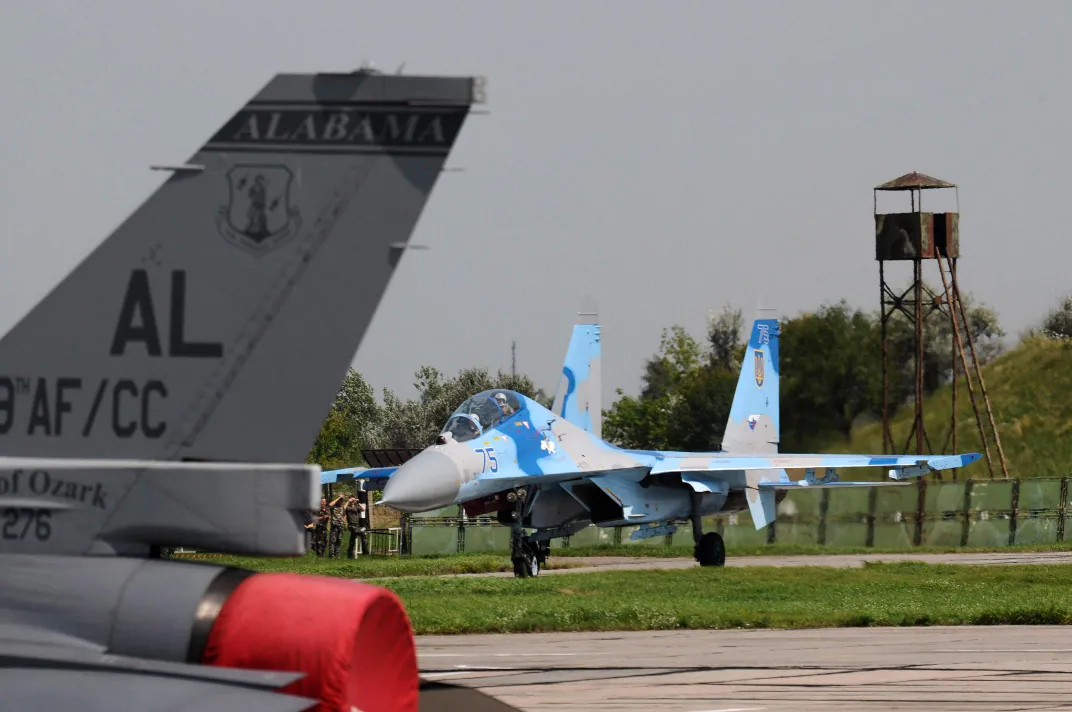
/https://tf-cmsv2-smithsonianmag-media.s3.amazonaws.com/filer/a3/64/a36468b7-28b2-4e59-b684-f1c65237b524/man.jpg)
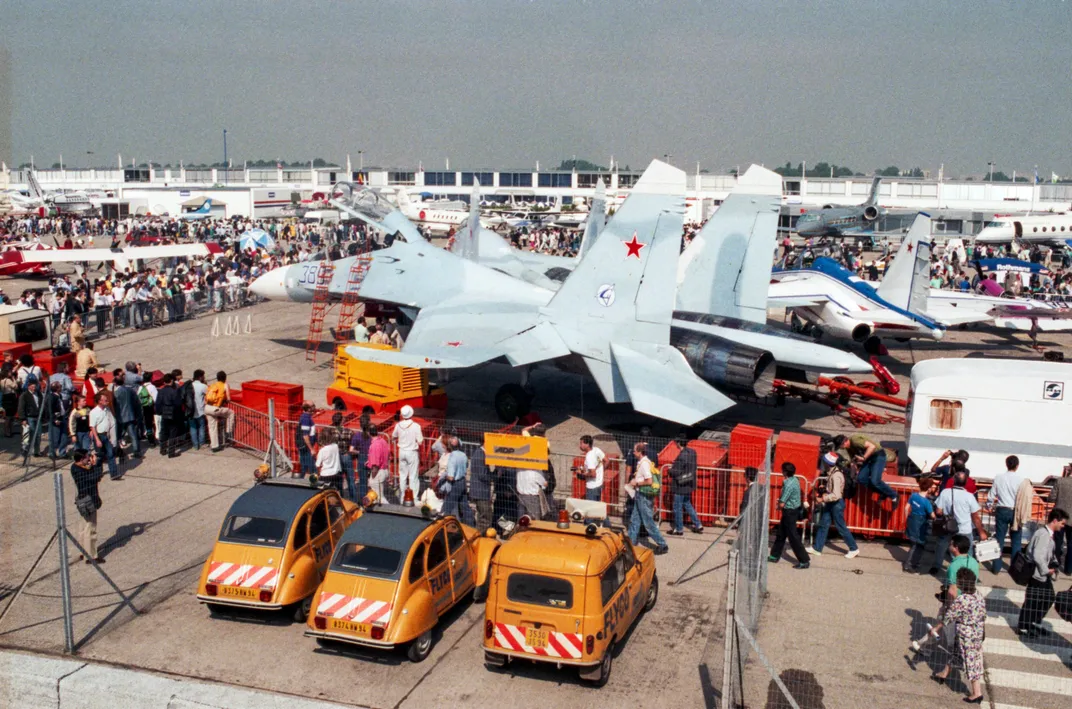
/https://tf-cmsv2-smithsonianmag-media.s3.amazonaws.com/filer/9f/d3/9fd3d1d8-245d-4ed6-b048-97d6ae2e2acd/08t_on2020_su27andil76finalsize_live.jpg)
